Enhanced Vibrational Spectroscopies as Tools for Small Molecule Biosensing
Abstract
:1. Introduction
2. IR Spectroscopy Applied to Direct and Label-Free Sensing of Small Molecules
2.1. Surface-Enhanced IR Techniques
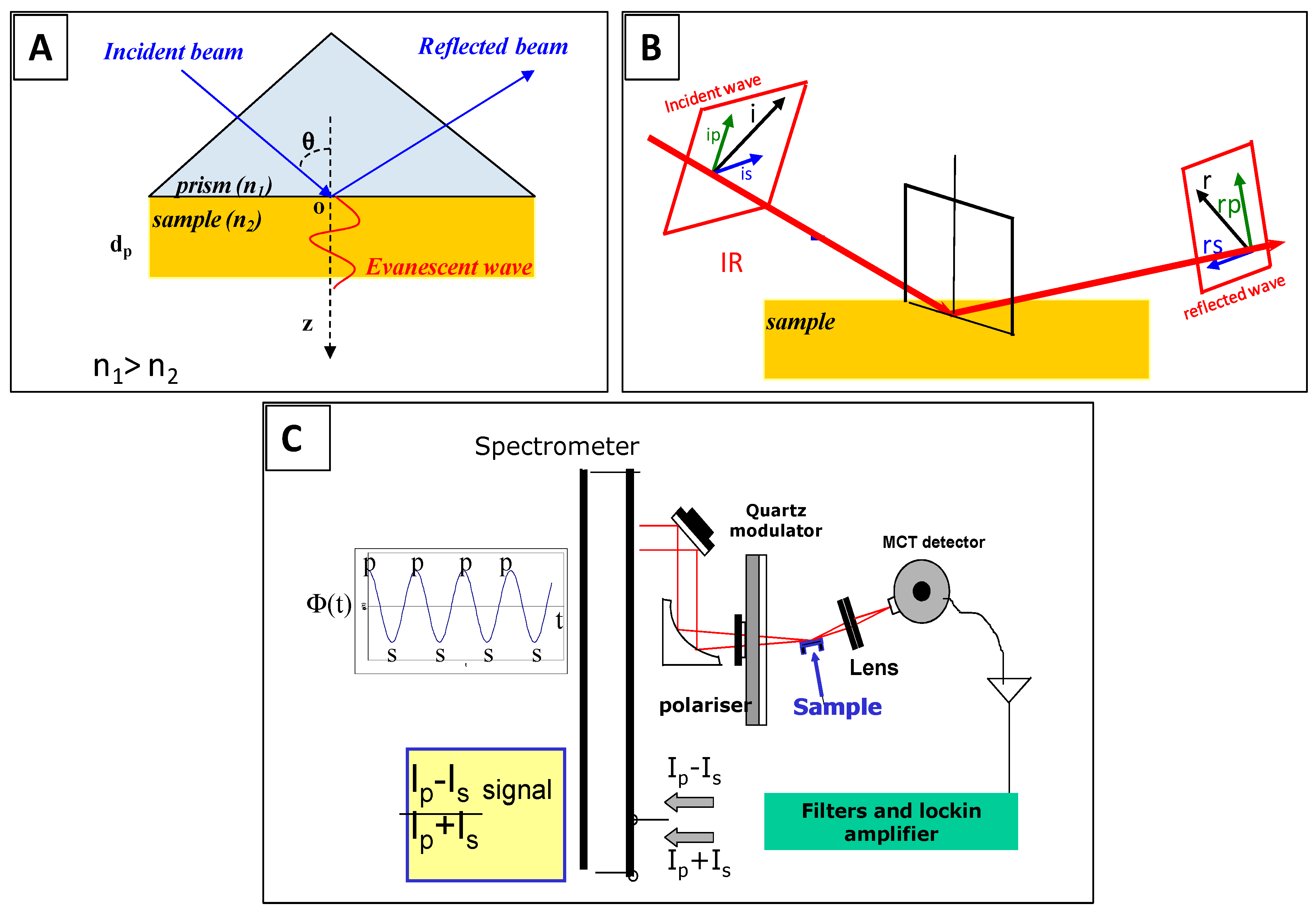
2.2. Surface IR Techniques to Monitor Biosensor Preparation
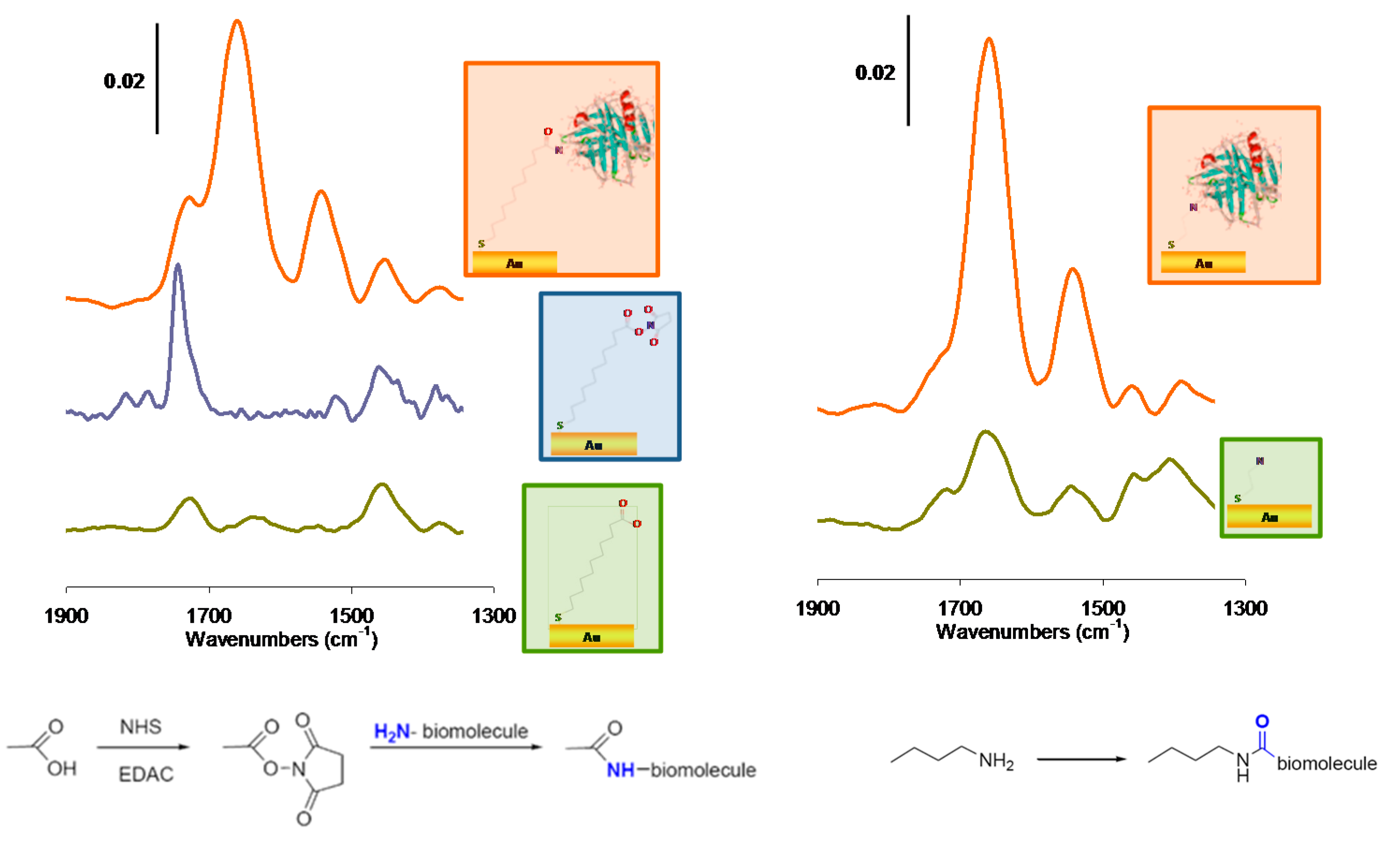
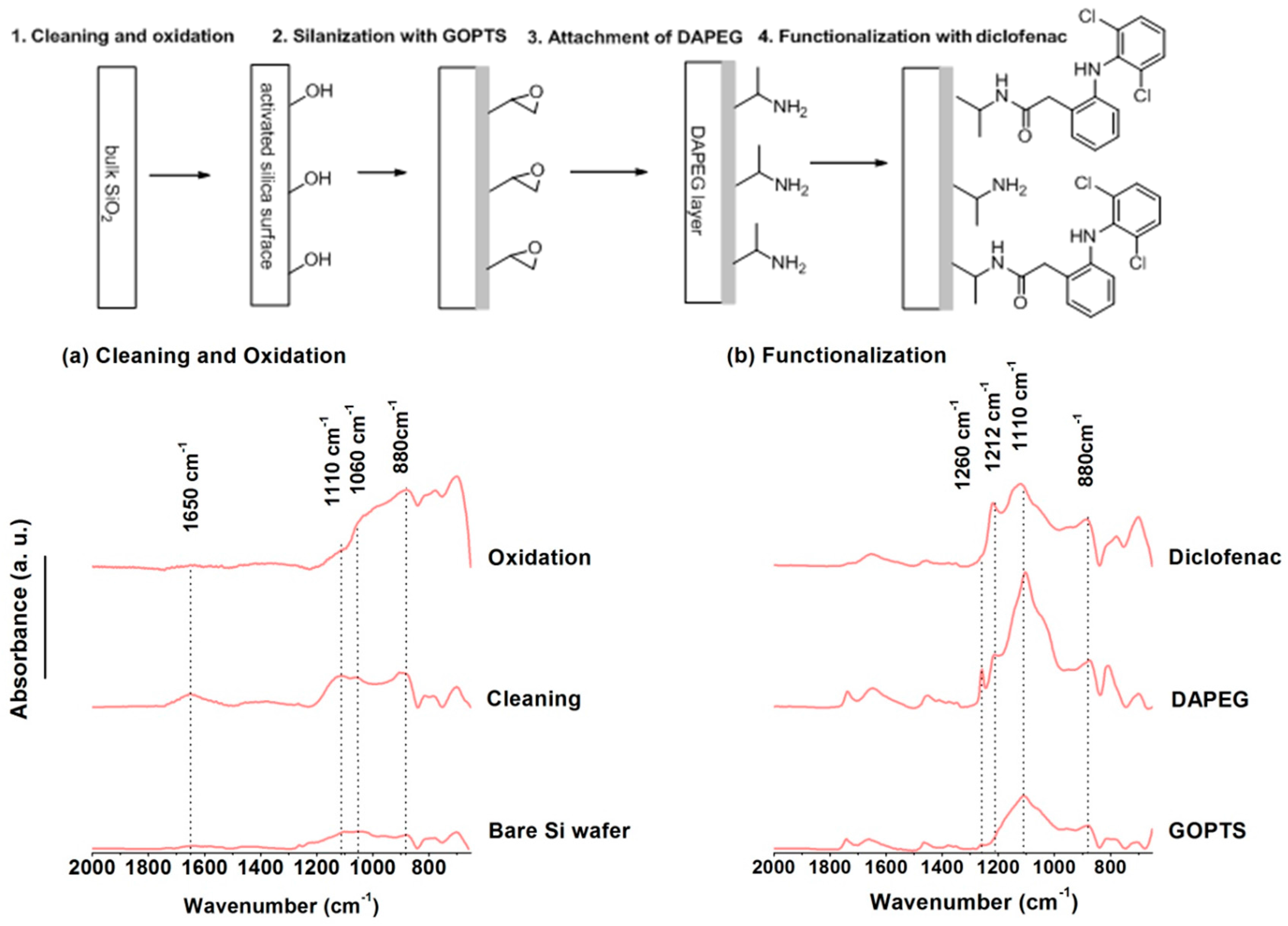
2.3. Surface IR Techniques for Small Molecules Biosensing
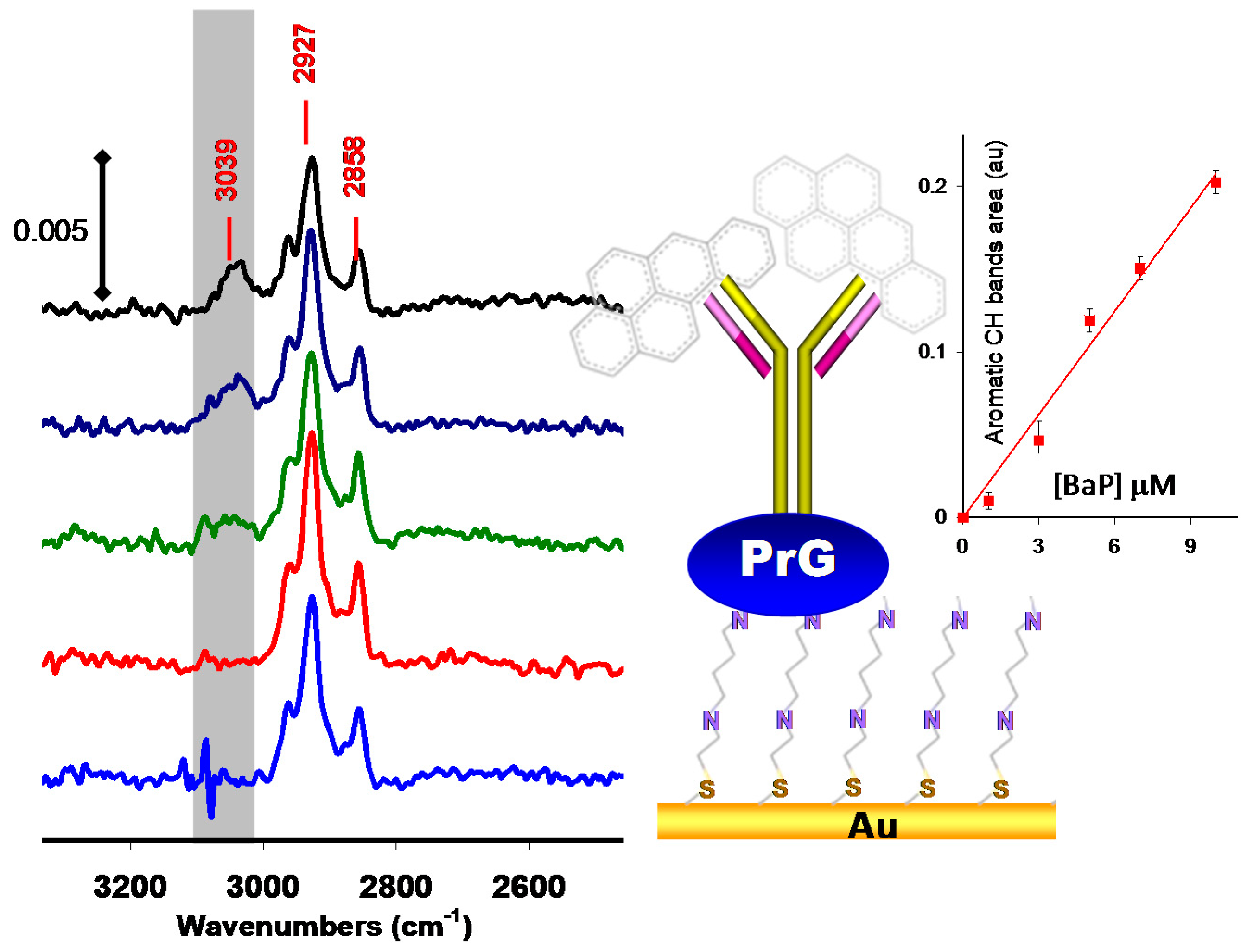
2.4. Localized Surface-Plasmon Field-Enhanced IR Spectroscopy
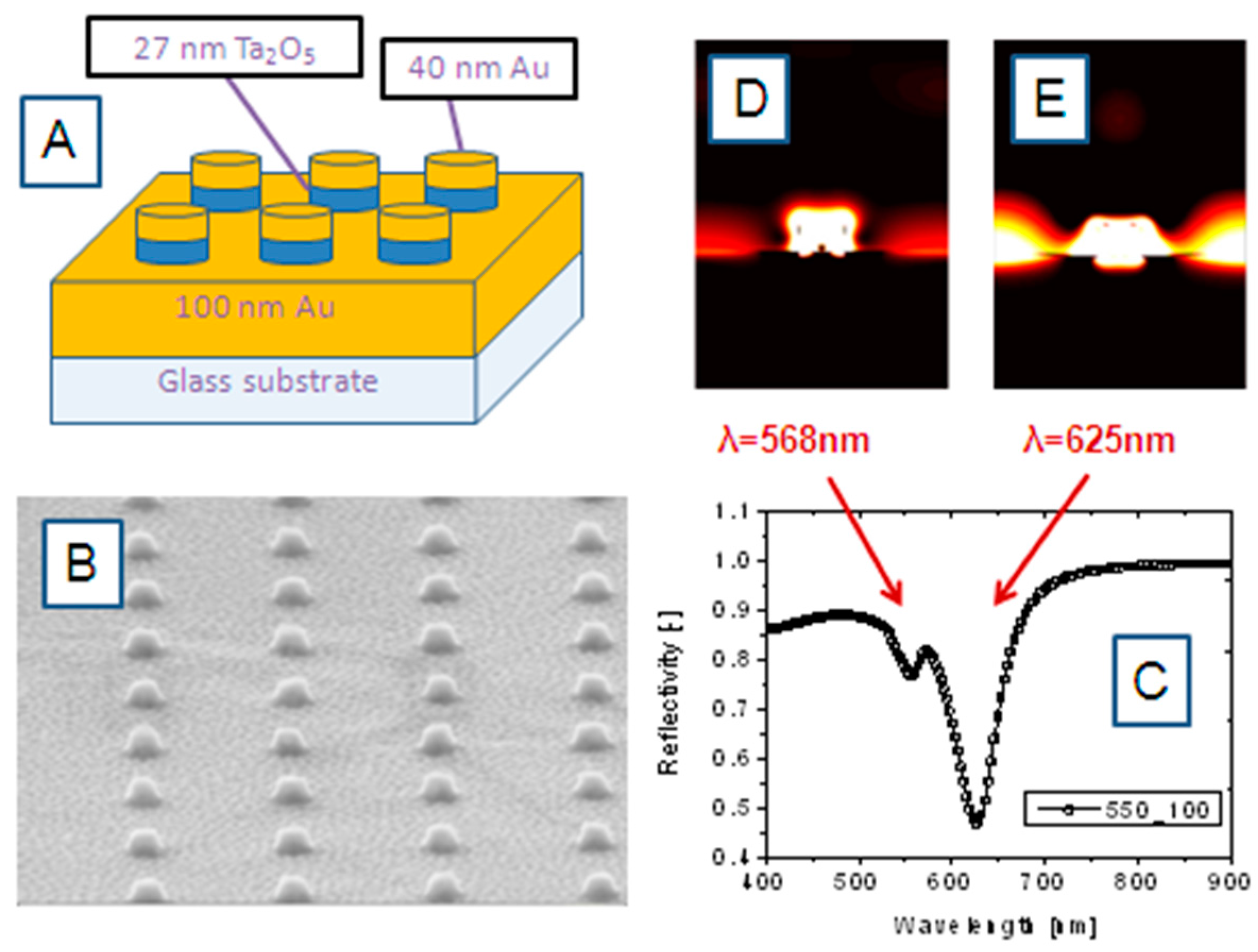
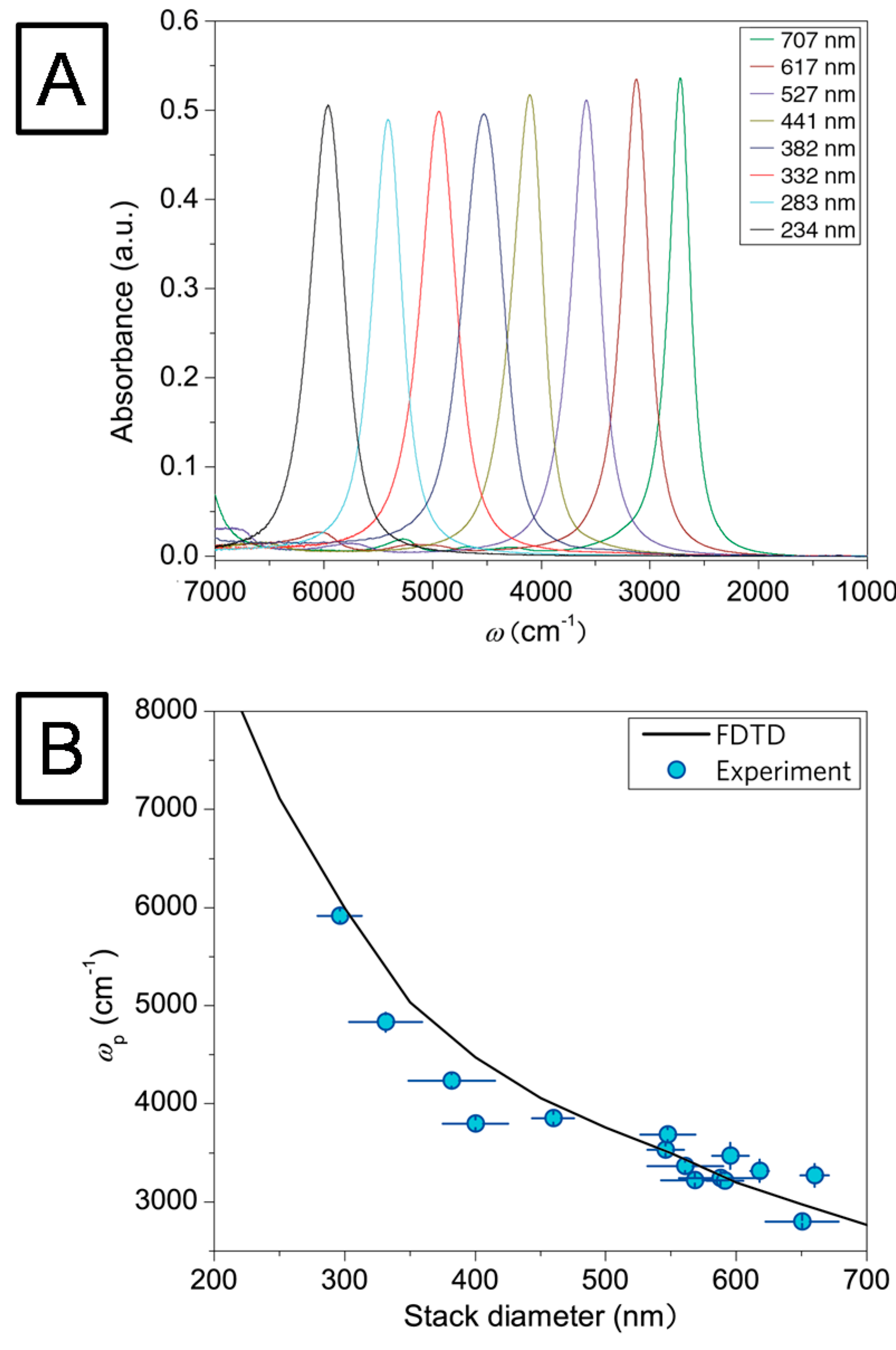
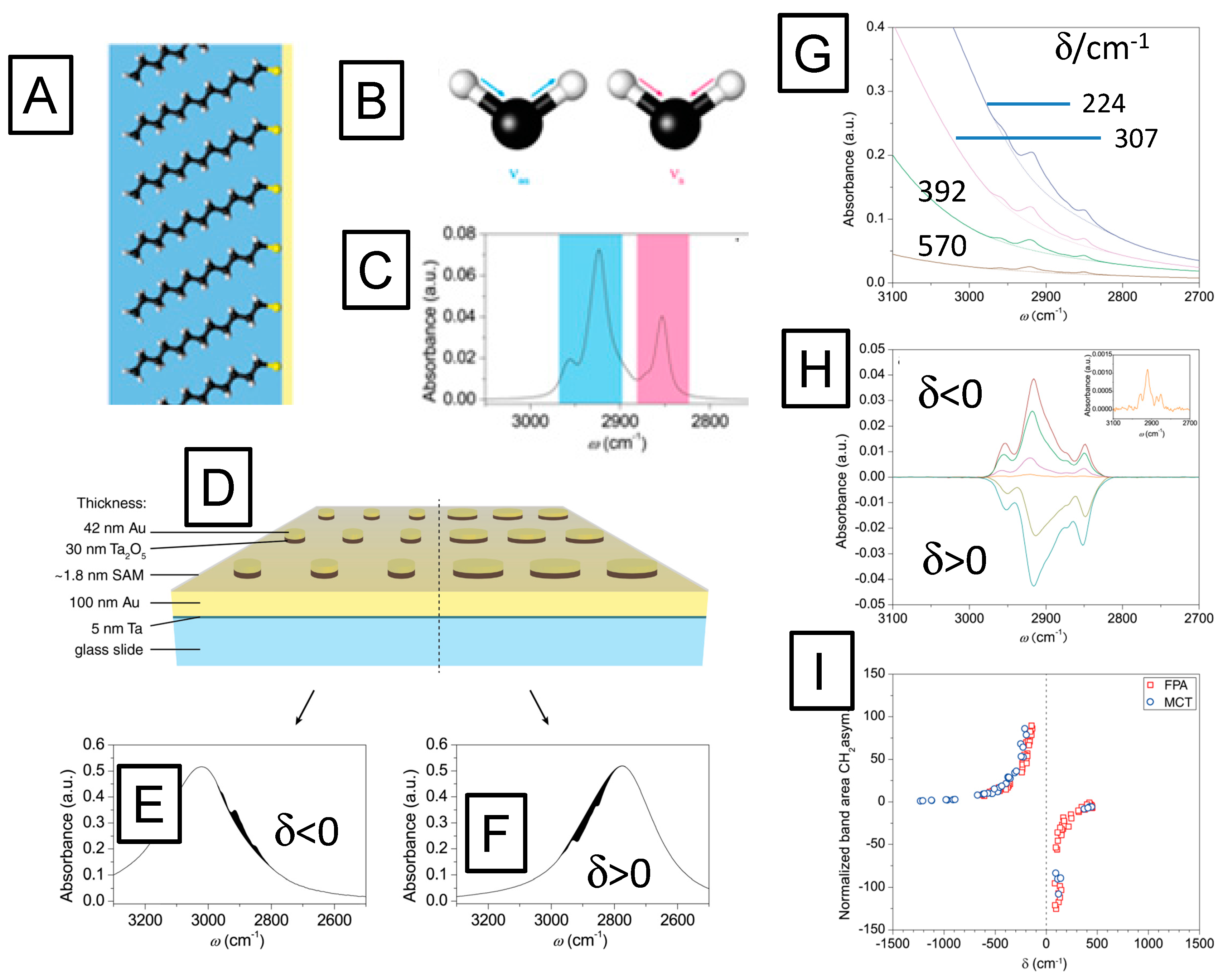
3. Surface Enhanced Raman Scattering and Biosensing
3.1. Principles of SERS
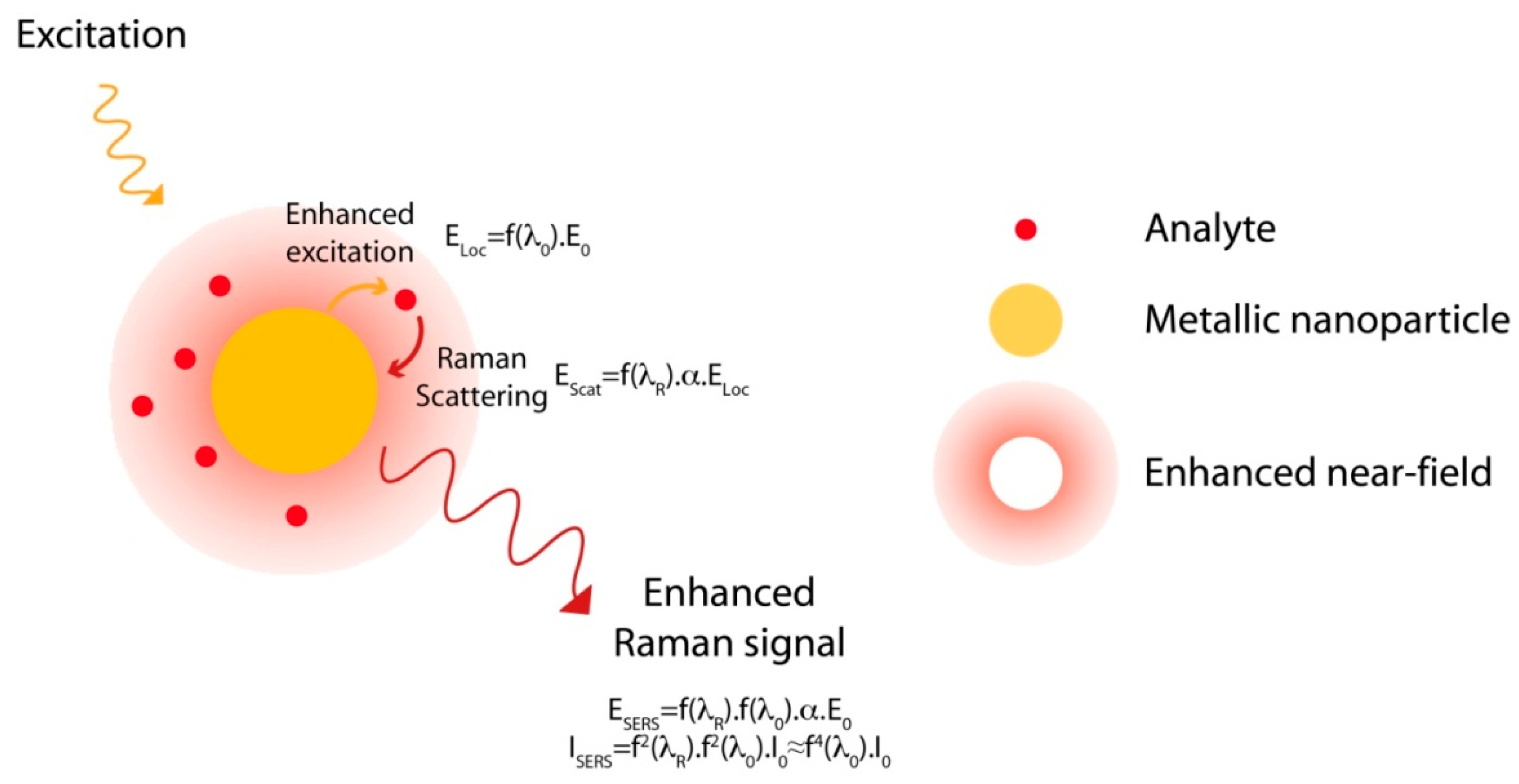
3.2. Sensors Based on SERS
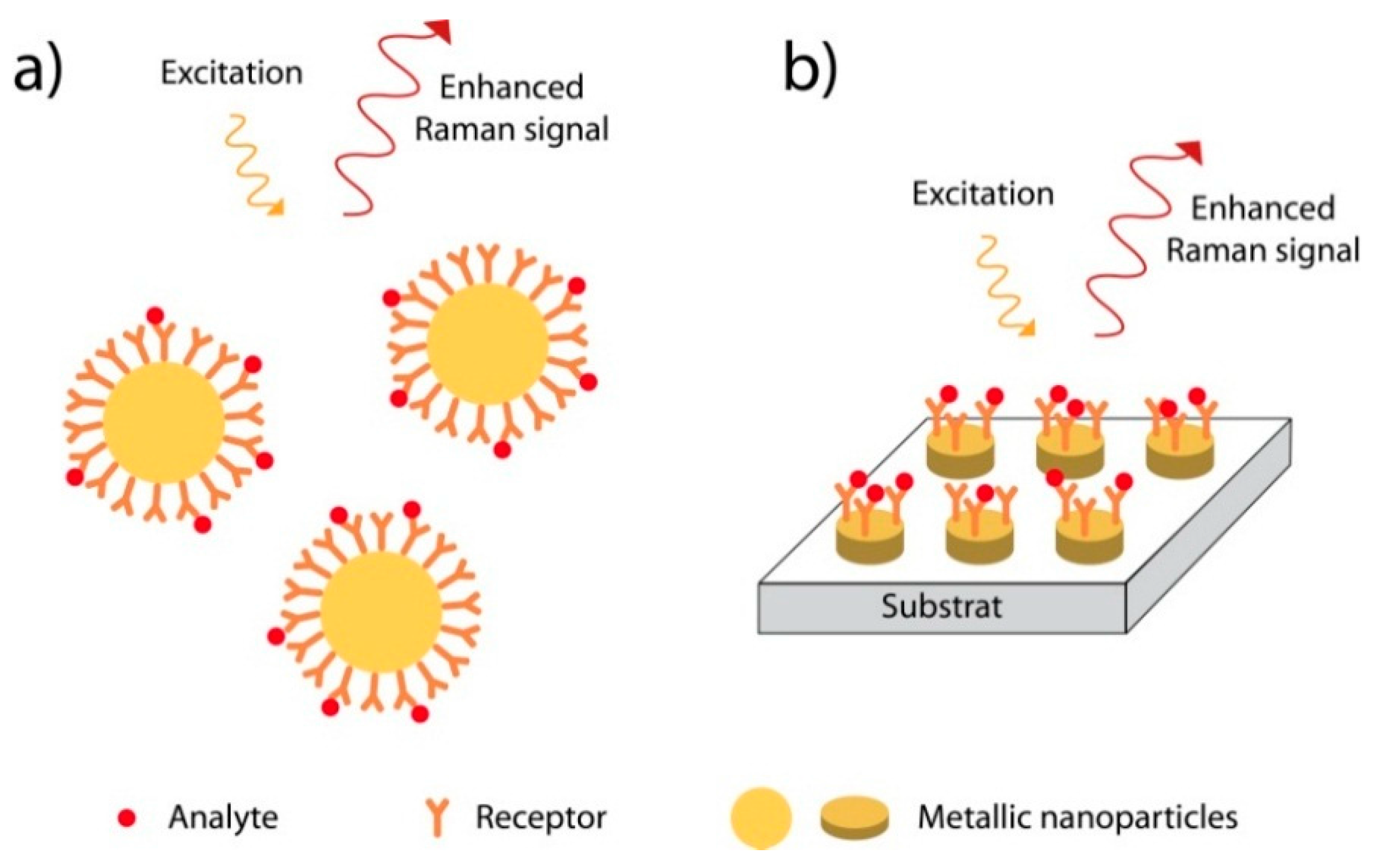
3.3. Detection of Chemical Compounds
3.4. Detection of Biomolecules
4. Tip Enhanced Raman Scattering
5. Conclusions
Acknowledgments
Conflicts of Interest
References
- Homola, J.; Yee, S.S.; Gauglitz, G. Surface plasmon resonance sensors: Review. Sens. Actuators B Chem. 1999, 54, 3–15. [Google Scholar] [CrossRef]
- Engvall, E.; Perlmann, P. Enzyme-linked immunosorbent assay (elisa) quantitative assay of immunoglobulin-G. Immunochemistry 1971, 8, 871–874. [Google Scholar] [CrossRef]
- Nagl, S.; Schaeferling, M.; Wolfbeis, O.S. Fluorescence analysis in microarray technology. Microchim. Acta 2005, 151, 1–21. [Google Scholar] [CrossRef]
- Weber, J.A.; Baxter, D.H.; Zhang, S.L.; Huang, D.Y.; Huang, K.H.; Lee, M.J.; Galas, D.J.; Wang, K. The MicroRNA Spectrum in 12 Body Fluids. Clin. Chem. 2010, 56, 1733–1741. [Google Scholar] [CrossRef] [PubMed]
- White, J.; Truesdell, K.; Williams, L.B.; AtKisson, M.S.; Kauer, J.S. Solid-state, dye-labeled DNA detects volatile compounds in the vapor phase. PLoS Biol. 2008, 6, 30–36. [Google Scholar] [CrossRef] [PubMed]
- Modak, A.S. Single time point diagnostic breath tests: A review. J. Breath Res. 2010, 4. [Google Scholar] [CrossRef] [PubMed]
- Mirabella, F.M. Internal-Reflection Spectroscopy. Appl. Spectrosc. Rev. 1985, 21, 45–178. [Google Scholar] [CrossRef]
- Lefevre, G. In situ Fourier-transform infrared spectroscopy studies of inorganic ions adsorption on metal oxides and hydroxides. Adv. Colloid Interface Sci. 2004, 107, 109–123. [Google Scholar] [CrossRef] [PubMed]
- Chittur, K.K. FTIR/ATR for protein adsorption to biomaterial surfaces. Biomaterials 1998, 19, 357–369. [Google Scholar] [CrossRef]
- Blaudez, D.; Buffeteau, T.; Cornut, J.C.; Desbat, B.; Escafre, N.; Pezolet, M.; Turlet, J.M. Polarization-modulated FT-IR spectroscopy of a spread monolayer at the air-water-interface. Appl. Spectrosc. 1993, 47, 869–874. [Google Scholar] [CrossRef]
- Blaudez, D.; Turlet, J.M.; Dufourcq, J.; Bard, D.; Buffeteau, T.; Desbat, B. Investigations at the air/water interface using polarization modulation IR spectroscopy. J. Chem. Soc. Faraday Trans. 1996, 92, 525–530. [Google Scholar] [CrossRef]
- Kundu, J.; Le, F.; Nordlander, P.; Halas, N.J. Surface enhanced infrared absorption (SEIRA) spectroscopy on nanoshell aggregate substrates. Chem. Phys. Lett. 2008, 452, 115–119. [Google Scholar] [CrossRef]
- Pronkin, S.; Wandlowski, T. ATR-SEIRAS—An approach to probe the reactivity of Pd-modified quasi-single crystal gold film electrodes. Surface Sci. 2004, 573, 109–127. [Google Scholar] [CrossRef]
- Socrates, G. Infrared Characteristic Group Frequencies; John Wiley & Sons Ltd.: Chichester, UK, 1980. [Google Scholar]
- Laibinis, P.E.; Whitesides, G.M.; Allara, D.L.; Tao, Y.T.; Parikh, A.N.; Nuzzo, R.G. Comparison of the Structures and Wetting Properties of Self-Assembled Monolayers of Normal-Alkanethiols on the Coinage Metal-Surfaces, Cu, Ag, Au. J. Am. Chem. Soc. 1991, 113, 7152–7167. [Google Scholar] [CrossRef]
- Love, J.C.; Estroff, L.A.; Kriebel, J.K.; Nuzzo, R.G.; Whitesides, G.M. Self-assembled monolayers of thiolates on metals as a form of nanotechnology. Chem. Rev. 2005, 105, 1103–1169. [Google Scholar] [CrossRef] [PubMed]
- Nuzzo, R.G.; Dubois, L.H.; Allara, D.L. Fundamental-Studies of Microscopic Wetting on Organic-Surfaces.1. Formation and Structural Characterization of a Self-Consistent Series of Polyfunctional Organic Monolayers. J. Am. Chem. Soc. 1990, 112, 558–569. [Google Scholar] [CrossRef]
- Briand, E.; Gu, C.; Boujday, S.; Salmain, M.; Herry, J.M.; Pradier, C.M. Functionalization of gold surfaces with thiolate SAMs: Topography/bioactivity relationship—A combined FT-RAIRS, AFM and QCM investigation. Surf. Sci. 2007, 601, 3850–3855. [Google Scholar] [CrossRef]
- Pradier, C.M.; Salmain, M.; Boujday, S. IR Spectroscopy for Biorecognition and Molecular Sensing, Biointerface Characterization by Advanced IR Spectroscopy; Elsevier: Amsterdam, The Netherlands, 2011; pp. 167–216. [Google Scholar]
- Vallee, A.; Humblot, V.; Al Housseiny, R.; Boujday, S.; Pradier, C.-M. BSA adsorption on aliphatic and aromatic acid SAMs: Investigating the effect of residual surface charge and sublayer nature. Colloids Surf. B 2013, 109, 136–142. [Google Scholar] [CrossRef] [PubMed]
- Bedford, E.E.; Boujday, S.; Humblot, V.; Gu, F.X.; Pradier, C.-M. Effect of SAM chain length and binding functions on protein adsorption: β-Lactoglobulin and apo-transferrin on gold. Colloids Surf. B 2014, 116, 489–496. [Google Scholar] [CrossRef] [PubMed]
- Mercier, D.; Haddada, M.B.; Huebner, M.; Knopp, D.; Niessner, R.; Salmain, M.; Proust, A.; Boujday, S. Polyoxometalate nanostructured gold surfaces for sensitive biosensing of benzo[a]pyrene. Sens. Actuators B Chem. 2015, 209, 770–774. [Google Scholar] [CrossRef]
- Mercier, D.; Boujday, S.; Annabi, C.; Villanneau, R.; Pradier, C.-M.; Proust, A. Bifunctional Polyoxometalates for Planar Gold Surface Nanostructuration and Protein Immobilization. J. Phys. Chem. C 2012, 116, 13217–13224. [Google Scholar] [CrossRef]
- Thebault, P.; Boujday, S.; Senechal, H.; Pradier, C.-M. Investigation of an Allergen Adsorption on Amine- and Acid-Terminated Thiol Layers: Influence on Their Affinity to Specific Antibodies. J. Phys. Chem. B 2010, 114, 10612–10619. [Google Scholar] [CrossRef] [PubMed]
- Boujday, S.; Bantegnie, A.; Briand, E.; Marnet, P.-G.; Salmain, M.; Pradier, C.-M. In-Depth Investigation of Protein Adsorption on Gold Surfaces: Correlating the Structure and Density to the Efficiency of the Sensing Layer. J. Phys. Chem. B 2008, 112, 6708–6715. [Google Scholar] [CrossRef] [PubMed]
- Vallant, T.; Kattner, J.; Brunner, H.; Mayer, U.; Hoffmann, H. Investigation of the formation and structure of self-assembled alkylsiloxane monolayers on silicon using in situ attenuated total reflection infrared spectroscopy. Langmuir 1999, 15, 5339–5346. [Google Scholar] [CrossRef]
- Rochat, N.; Chabli, A.; Bertin, F.; Olivier, M.; Vergnaud, C.; Mur, P. Attenuated total reflection spectroscopy for infrared analysis of thin layers on a semiconductor substrate. J. Appl. Phys. 2002, 91, 5029–5034. [Google Scholar] [CrossRef]
- Aissaoui, N.; Bergaoui, L.; Landoulsi, J.; Lambert, J.-F.; Boujday, S. Silane Layers on Silicon Surfaces: Mechanism of Interaction, Stability, and Influence on Protein Adsorption. Langmuir 2012, 28, 656–665. [Google Scholar] [CrossRef] [PubMed]
- Ben Haddada, M.; Blanchard, J.; Casale, S.; Krafft, J.-M.; Vallee, A.; Methivier, C.; Boujday, S. Optimizing the immobilization of gold nanoparticles on functionalized silicon surfaces: Amine- vs. thiol-terminated silane. Gold Bull. 2013, 46, 335–341. [Google Scholar] [CrossRef]
- Zawisza, I.; Wittstock, G.; Boukherroub, R.; Szunerits, S. PM IRRAS investigation of thin silica films deposited on gold. Part 1. Theory and proof of concept. Langmuir 2007, 23, 9303–9309. [Google Scholar] [CrossRef] [PubMed]
- Zawisza, I.; Wittstock, G.; Boukherroub, R.; Szunerits, S. Polarization modulation infrared reflection absorption spectroscopy investigations of thin silica films deposited on gold. 2. Structural analysis of a 1,2-dimyristoyl-sn-glycero-3-phosphocholine bilayer. Langmuir 2008, 24, 3922–3929. [Google Scholar] [CrossRef] [PubMed]
- Huebner, M.; Haddada, M.B.; Methivier, C.; Niessner, R.; Knopp, D.; Boujday, S. Layer-by-layer generation of PEG-based regenerable immunosensing surfaces for small-sized analytes. Biosens. Bioelectron. 2014, 67, 334–341. [Google Scholar] [CrossRef] [PubMed]
- Boujday, S.; Briandet, R.; Salmain, M.; Herry, J.-M.; Marnet, P.-G.; Gautier, M.; Pradier, C.-M. Detection of pathogenic Staphylococcus aureus bacteria by gold based immunosensors. Microchim. Acta 2008, 163, 203–209. [Google Scholar] [CrossRef]
- Brewer, S.H.; Allen, A.M.; Lappi, S.E.; Chasse, T.L.; Briggman, K.A.; Gorman, C.B.; Franzen, S. Infrared detection of a phenylboronic acid terminated alkane thiol monolayer on gold surfaces. Langmuir 2004, 20, 5512–5520. [Google Scholar] [CrossRef] [PubMed]
- Brewer, S.H.; Anthireya, S.J.; Lappi, S.E.; Drapcho, D.L.; Franzen, S. Detection of DNA hybridization on gold surfaces by polarization modulation infrared reflection absorption spectroscopy. Langmuir 2002, 18, 4460–4464. [Google Scholar] [CrossRef]
- Moses, S.; Brewer, S.H.; Lowe, L.B.; Lappi, S.E.; Gilvey, L.B.G.; Sauthier, M.; Tenent, R.C.; Feldheim, D.L.; Franzen, S. Characterization of single- and double-stranded DNA on gold surfaces. Langmuir 2004, 20, 11134–11140. [Google Scholar] [CrossRef] [PubMed]
- Mateo-Marti, E.; Briones, C.; Pradier, C.M.; Martin-Gago, J.A. A DNA biosensor based on peptide nucleic acids on gold surfaces. Biosens. Bioelectron. 2007, 22, 1926–1932. [Google Scholar] [CrossRef] [PubMed]
- Mateo-Marti, E.; Briones, C.; Rogero, C.; Gomez-Navarro, C.; Methivier, C.; Pradier, C.M.; Martin-Gago, J.A. Nucleic acid interactions with pyrite surfaces. Chem. Phys. 2008, 352, 11–18. [Google Scholar] [CrossRef]
- Miguel, A.H.; Kirchstetter, T.W.; Harley, R.A.; Hering, S.V. On-Road Emissions of Particulate Polycyclic Aromatic Hydrocarbons and Black Carbon from Gasoline and Diesel Vehicles. Environ. Sci. Technol. 1998, 32, 450–455. [Google Scholar] [CrossRef]
- Faehnrich, K.A.; Pravda, M.; Guilbault, G.G. Disposable Amperometric Immunosensor for the Detection of Polycyclic Aromatic Hydrocarbons (PAHs) Using Screen-Printed Electrodes. Biosens. Bioelectron. 2003, 18, 73–82. [Google Scholar] [CrossRef]
- Gobi, K.V.; Miura, N. Highly Sensitive and Interference-free Simultaneous Detection of Two Polycyclic Aromatic Hydrocarbons at Parts-per-trillion Levels Using a Surface Plasmon Resonance Immunosensor. Sens. Actuators B Chem. 2004, 103, 265–271. [Google Scholar] [CrossRef]
- Liu, M.; Li, Q.X.; Rechnitz, G.A. Flow Injection Immunosensing of Polycyclic Aromatic Hydrocarbons with a Quartz Crystal Microbalance. Anal. Chim. Acta 1999, 387, 29–38. [Google Scholar] [CrossRef]
- Boujday, S.; Gu, C.; Girardot, M.; Salmain, M.; Pradier, C.-M. Surface IR applied to rapid and direct immunosensing of environmental pollutants. Talanta 2009, 78, 165–170. [Google Scholar] [CrossRef] [PubMed]
- Boujday, S.; Nasri, M.; Salmain, C.-M. Pradier, Surface IR immunosensors for label-free detection of benzo[a]pyrene. Biosens. Bioelectron. 2010, 26, 1750–1754. [Google Scholar] [CrossRef] [PubMed]
- Grosserueschkamp, M.; Nowak, C.; Schach, D.; Schaertl, W.; Knoll, W.; Naumann, R.L.C. Silver Surfaces with Optimized Surface Enhancement by Self-Assembly of Silver Nanoparticles for Spectroelectrochemical Applications. J. Phys. Chem. C 2009, 113, 17698–17704. [Google Scholar] [CrossRef]
- Srajer, J.; Schwaighofer, A.; Ramer, G.; Rotter, S.; Guenay, B.; Kriegner, A.; Knoll, W.; Lendl, B.; Nowak, C. Double-layered nanoparticle stacks for surface enhanced infrared absorption spectroscopy. Nanoscale 2014, 6, 127–131. [Google Scholar] [CrossRef] [PubMed]
- Oskooi, A.F.; Roundy, D.; Ibanescu, M.; Bermel, P.; Joannopoulos, J.D.; Johnson, S.G. MEEP: A flexible free-software package for electromagnetic simulations by the FDTD method. Comput. Phys. Commun. 2010, 181, 687–702. [Google Scholar] [CrossRef]
- Giannini, V.; Francescato, Y.; Amrania, H.; Phillips, C.C.; Maier, S.A. Fano Resonances in Nanoscale Plasmonic Systems: A Parameter-Free Modeling Approach. Nano Lett. 2011, 11, 2835–2840. [Google Scholar] [CrossRef] [PubMed]
- Osley, E.J.; Biris, C.G.; Thompson, P.G.; Jahromi, R.R.F.; Warburton, P.A.; Panoiu, N.C. Fano Resonance Resulting from a Tunable Interaction between Molecular Vibrational Modes and a Double Continuum of a Plasmonic Metamolecule. Phys. Rev. Lett. 2013, 110. [Google Scholar] [CrossRef]
- Neubrech, F.; Pucci, A. Plasmonic Enhancement of Vibrational Excitations in the Infrared. IEEE J. Sel. Top. Quantum Electron. 2013, 19. [Google Scholar] [CrossRef]
- Guillot, N.; de la Chapelle, M.L. Lithographied nanostructures as nanosensors. J. Nanophoton. 2012, 6, 064506. [Google Scholar] [CrossRef]
- Schlücker, S. Surface-Enhanced Raman Spectroscopy: Concepts and Chemical Applications. Angew. Chem. Int. Ed. 2014, 53, 4756–4795. [Google Scholar] [CrossRef] [PubMed]
- Christensen, S.D. Raman cross sections of chemical agents and simulants. Appl. Spectrosc. 1988, 42, 318–321. [Google Scholar] [CrossRef]
- Aggarwal, R.L.; Farrar, L.W.; Diebold, E.D.; Polla, D.L. Measurement of the absolute Raman scattering cross section of the 1584-cm−1 band of benzenethiol and the surface-enhanced Raman scattering cross section enhancement factor for femtosecond laser-nanostructured substrate. J. Raman Spectrosc. 2009, 40, 1331–1333. [Google Scholar] [CrossRef]
- Fleischmann, M.; Hendra, P.J.; McQuillan, A.J. Raman spectra of pyridine adsorbed at a silver electrode. Chem. Phys. Lett. 1974, 26, 163–166. [Google Scholar] [CrossRef]
- Moskovits, M. Surface Enhanced Spectroscopy. Rev. Mod. Phys. 1985, 57, 783–826. [Google Scholar] [CrossRef]
- Campion, A.; Kambhampati, P. Surface Enhanced Raman Scattering. Chem. Soc. Rev. 1998, 27, 241–250. [Google Scholar] [CrossRef]
- Guillot, N.; de la Chapelle, M.L. The electromagnetic effect of precisely controlled nanostructures in Surface Enhanced Raman Scattering. J. Quant. Spectrosc. Radiat. Transf. 2012, 113, 2321–2333. [Google Scholar] [CrossRef]
- Le Ru, E.C.; Blackie, E.; Meyer, M.; Etchegoin, P.G. Surface Enhanced Raman Scattering Enhancement Factors: A Comprehensive Study. J. Phys. Chem. C 2007, 111, 13794–13803. [Google Scholar] [CrossRef]
- Nie, S.; Emory, S.R. Probing Single Molecules and Single Nanoparticles by Surface-Enhanced Raman Scattering. Science 1997, 275, 1102–1106. [Google Scholar] [CrossRef] [PubMed]
- Kneipp, K.; Wang, Y.; Kneipp, H.; Perelman, L.T.; Itzkan, I.; Dasari, R.R.; Feld, M.S. Single Molecule Detection Using Surface-Enhanced Raman Scattering (SERS). Phys. Rev. Lett. 1997, 78, 1667–1670. [Google Scholar] [CrossRef]
- Kedem, O.; Tesler, A.B.; Vaskevich, A.; Rubinstein, I. Sensitivity and Optimization of Localized Surface Plasmon Resonance Transducers. ACS Nano 2011, 5, 748–760. [Google Scholar] [CrossRef] [PubMed]
- Haes, A.J.; Zou, S.; Schatz, G.C.; van Duyne, R.P. A Nanoscale Optical Biosensor: The Long Range Distance Dependence of the Localized Surface Plasmon Resonance of Noble Metal Nanoparticles. J. Phys. Chem. B 2004, 108, 109–116. [Google Scholar] [CrossRef]
- Dieringer, J.A.; McFarland, A.D.; Shah, N.C.; Stuart, D.A.; Whitney, A.V.; Yonzon, C.R.; Young, M.A.; Zhang, X.; van Duyne, R.P. Introductory Lecture Surface enhanced Raman spectroscopy: New materials, concepts, characterization tools, and applications. Faraday Discuss. 2006, 132, 9–26. [Google Scholar] [CrossRef] [PubMed]
- Jiang, X.; Yang, M.; Meng, Y.; Jiang, W.; Zhan, J. Cysteamine-Modified Silver Nanoparticle Aggregates for Quantitative SERS Sensing of Pentachlorophenol with a Portable Raman Spectrometer. ACS Appl. Mater. Interfaces 2013, 5, 6902–6908. [Google Scholar] [CrossRef] [PubMed]
- Murphy, T.; Schmidt, H.; Kronfeldt, H.D. Use of sol-gel techniques in the development of surface-enhanced Raman scattering (SERS) substrates suitable for in situ detection of chemicals in sea-water. Appl. Phys. B 1999, 69, 147–150. [Google Scholar] [CrossRef]
- Peron, O.; Rinnert, E.; Toury, T.; de la Chapelle, M.L.; Compere, C. Quantitative SERS sensors for environmental analysis of naphthalene. Analyst 2011, 136, 1018–1022. [Google Scholar] [CrossRef] [PubMed]
- Yang, L.; Ma, L.; Chen, G.; Liu, J.; Tian, Z.Q. Ultrasensitive SERS Detection of TNT by Imprinting Molecular Recognition Using a New Type of Stable Substrate. Chem. Eur. J. 2010, 16, 12683–12693. [Google Scholar] [CrossRef] [PubMed]
- Hill, W.; Fallourd, V.; Klockow, D. Investigation of the Adsorption of Gaseous Aromatic Compounds at Surfaces Coated with Heptakis(6-thio-6-deoxy)-β-cyclodextrin by Surface-Enhanced Raman Scattering. J. Phys. Chem. B 1999, 103, 4707–4713. [Google Scholar] [CrossRef]
- Xie, Y.; Wang, X.; Han, X.; Song, W.; Ruan, W.; Liu, J.; Zhao, B.; Ozaki, Y. Selective SERS detection of each polycyclic aromatic hydrocarbon (PAH) in a mixture of five kinds of PAHs. J. Raman Spectrosc. 2011, 42, 945–950. [Google Scholar] [CrossRef]
- Xie, Y.; Wang, X.; Han, X.; Xue, X.; Ji, W.; Qi, Z.; Liu, J.; Zhao, B.; Ozaki, Y. Sensing of polycyclic aromatic hydrocarbons with cyclodextrin inclusion complexes on silver nanoparticles by surface-enhanced Raman scattering. Analyst 2010, 135, 1389–1394. [Google Scholar] [CrossRef] [PubMed]
- Xu, J.Y.; Wang, J.; Kong, L.T.; Zheng, G.C.; Guo, Z.; Liu, J.H. SERS detection of explosive agent by macrocyclic compound functionalized triangular gold nanoprisms. J. Raman Spectrosc. 2011, 42, 1728–1735. [Google Scholar] [CrossRef]
- Wang, J.; Kong, L.T.; Guo, Z.; Xu, J.Y.; Liu, J.H. Synthesis of novel decorated one-dimensional gold nanoparticle and its application in ultrasensitive detection of insecticide. J. Mater. Chem. 2010, 20, 5271–5279. [Google Scholar] [CrossRef]
- Guerrini, L.; Garcia-Ramos, J.V.; Domingo, C.; Sanchez-Cortes, S. Sensing Polycyclic Aromatic Hydrocarbons with Dithiocarbamate-Functionalized Ag Nanoparticles by Surface-Enhanced Raman Scattering. Anal. Chem. 2009, 81, 953–960. [Google Scholar] [CrossRef] [PubMed]
- De Gelder, J.; de Gussem, K.; Vandenabeele, P.; Moens, L. Reference database of Raman spectra of biological molecules. J. Raman Spectrosc. 2007, 38, 1133–1147. [Google Scholar] [CrossRef]
- Siebert, F.; Hildebrandt, P. Vibrational Spectroscopy in Life Science; WILEY-VCH Verlag GmbH & Co. KGaA: Weinheim, Germany, 2008. [Google Scholar]
- Carter, E.A.; Edwards, H.G. Infrared and Raman Spectroscopy of Biological Materials; Gremlich, H.-U., Yan, B., Eds.; Marcel Dekker: New York, NY, USA, 2002; pp. 421–475. [Google Scholar]
- Siddhanta, S.; Karthigeyan, D.; Kundu, P.P.; Kundub, T.K.; Narayana, C. Surface enhanced Raman spectroscopy of Aurora kinases: Direct, ultrasensitive detection of autophosphorylation. RSC Adv. 2013, 3, 4221–4230. [Google Scholar] [CrossRef]
- David, C.; Guillot, N.; Shen, H.; Toury, T.; de la Chapelle, M.L. SERS detection of biomolecules using lithographed nanoparticles towards a reproducible SERS biosensor. Nanotechnology 2010, 21, 475501. [Google Scholar] [CrossRef] [PubMed] [Green Version]
- He, L.; Langlet, M.; Bouvier, P.; Calers, C.; Pradier, C.M.; Stambouli, V. New Insights into Surface-Enhanced Raman Spectroscopy Label-Free Detection of DNA on Ag°/TiO2 Substrate. J. Phys. Chem. C 2014, 118, 25658. [Google Scholar] [CrossRef]
- Barhoumi, A.; Halas, N.J. Label-Free Detection of DNA Hybridization Using Surface Enhanced Raman Spectroscopy. J. Am. Chem. Soc. 2010, 132, 12792–12793. [Google Scholar] [CrossRef] [PubMed]
- Das, G.; Mecarini, F.; Gentille, F.; de Angelis, F.; Mohan Kumar, H.G.; Candeloro, P.; Liberale, C.; Cuda, G.; di Fabrizio, E. Nano-patterned SERS substrate: Application for protein analysis vs. temperature. Biosens. Bioeletron. 2009, 24, 1693–1699. [Google Scholar] [CrossRef] [PubMed]
- Brulé, T.; Yockell-Lelièv̀re, H.; Bouheĺier, A.; Margueritat, J.; Markey, L.; Leray, A.; Dereux, A.; Finot, E. Sorting of Enhanced Reference Raman Spectra of a Single Amino Acid Molecule. J. Phys. Chem. C 2014, 118, 17975–17982. [Google Scholar] [CrossRef]
- Premasiri, W.R.; Lee, J.C.; Ziegler, L.D. Surface-Enhanced Raman Scattering of Whole Human Blood, Blood Plasma, and Red Blood Cells: Cellular Processes and Bioanalytical Sensing. J. Phys. Chem. B 2012, 116, 9376–9386. [Google Scholar] [CrossRef] [PubMed]
- Lin, D.; Feng, S.; Pan, J.; Chen, Y.; Lin, J.; Chen, G.; Xie, S.; Zeng, H.; Chen, R. Colorectal cancer detection by gold nanoparticle based surface-enhanced Raman spectroscopy of blood serum and statistical analysis. Opt. Express 2011, 19, 13565. [Google Scholar] [CrossRef] [PubMed]
- Shafer-Peltier, K.E.; Haynes, C.L.; Glucksberg, M.R.; van Duyne, R.P. Toward a Glucose Biosensor Based on Surface-Enhanced Raman Scattering. J. Am. Chem. Soc. 2003, 125, 588–593. [Google Scholar] [CrossRef] [PubMed]
- Stuart, D.A.; Yuen, J.M.; Shah, N.; Lyandres, O.; Yonzon, C.R.; Glucksberg, M.R.; Walsh, J.T.; van Duyne, R.P. In Vivo Glucose Measurement by Surface-Enhanced Raman Spectroscopy. Anal. Chem. 2006, 78, 7211–7215. [Google Scholar] [CrossRef] [PubMed]
- Zhang, X.; Shah, N.C.; van Duyne, R.P. Sensitive and selective chem/bio sensing based on surface-enhanced Raman spectroscopy (SERS). Vib. Spectrosc. 2006, 42, 2–8. [Google Scholar] [CrossRef]
- Galarreta, B.C.; Tabatabaei, M.; Guieu, V.; Peyrin, E.; Lagugné-Labarthet, F. Microfluidic channel with embedded SERS 2D platform for the aptamer detection of ochratoxin A. Anal. Bioanal. Chem. 2013, 405, 1613–1621. [Google Scholar] [CrossRef] [PubMed]
- Wen, G.; Zhou, L.; Li, T.; Liang, A.; Jiang, Z. A Sensitive Surface-enhanced Raman Scattering Method for Determination of Melamine with Aptamer-modified Nanosilver Probe. Chin. J. Chem. 2012, 30, 869–874. [Google Scholar] [CrossRef]
- Anderson, N.; Hartschuh, A.; Cronin, S.; Novotny, L. Nanoscale Vibrational Analysis of Single-Walled Carbon Nanotubes. J. Am. Chem. Soc. 2005, 127, 2533–2537. [Google Scholar] [CrossRef] [PubMed] [Green Version]
- Chen, C.; Hayazawa, N.; Kawata, S. A 1.7 nm resolution chemical analysis of carbon nanotubes by tip-enhanced Raman imaging in the ambient. Nat. Commun. 2014, 5, 3312. [Google Scholar] [CrossRef] [PubMed]
- Zhang, R.; Zhang, Y.; Dong, Z.; Jiang, S.; Zhang, C.; Chen, L.; Zhang, L.; Liao, Y.; Aizpurua, J.; Luo, Y.; et al. Chemical mapping of a single molecule by plasmon-enhanced Raman scattering. Nature 2013, 498, 82–86. [Google Scholar] [CrossRef] [PubMed]
- Hartschuh, A.; Anderson, N.; Novotny, L. Near-field Raman spectroscopy using a sharp metal tip. J. Microsc. 2003, 210, 234–240. [Google Scholar] [CrossRef] [PubMed]
- Hartschuh, A. Tip-Enhanced Near-Field Optical Microscopy. Angew. Chem. Int. Ed. Engl. 2008, 47, 8178–8191. [Google Scholar] [CrossRef] [PubMed]
- Kawata, S. Plasmonics for Nanoimaging and Nanospectroscopy. Appl. Spectrosc. 2013, 67, 117–125. [Google Scholar]
- Nicklaus, M.; Nauenheim, C.; Krayev, A.; Gavrilyuk, V.; Belyaev, A.; Ruediger, A. Tip enhanced Raman spectroscopy with objective scanner on opaque samples. Rev. Sci. Instrum. 2012, 83, 066102. [Google Scholar] [CrossRef] [PubMed]
- Su, W.; Roy, D. Visualizing graphene edges using tip-enhanced Raman spectroscopy. J. Vac. Sci. Technol. B 2013, 31, 041808. [Google Scholar] [CrossRef]
- Poliani, E.; Nipper, F.; Maultzsch, J. Effect of gap modes on graphene and multilayer graphene in tip-enhanced Raman spectroscopy. Phys. Status Solidi B 2012, 249, 2511–2514. [Google Scholar] [CrossRef]
- Ghislandi, M.; Hoffmann, G.; Tkalya, E.; Xue, L.; de With, G. Tip-Enhanced Raman Spectroscopy and Mapping of Graphene Sheets. Appl. Spectrosc. Rev. 2012, 47, 371–381. [Google Scholar] [CrossRef]
- Poliani, E.; Wagner, M.; Reparaz, J.; Mandl, M.; Strassburg, M.; Kong, X.; Trampert, A.; Torres, C.S.; Hoffmann, A.; Maultzsch, J. Nanoscale Imaging of InN Segregation and Polymorphism in Single Vertically Aligned InGaN/GaN Multi Quantum Well Nanorods by Tip-Enhanced Raman Scattering. Nano Lett. 2013, 13, 3205–3212. [Google Scholar] [CrossRef] [PubMed]
- Merlen, A.; Valmalette, J.C.; Gucciardi, P.G.; de la Chapelle, M.L.; Frigout, A.; Ossikovski, R. Depolarization effects in Tip Enhanced Raman Spectroscopy. J. Raman Spectrosc. 2009, 40, 1361–1370. [Google Scholar] [CrossRef]
- Gucciardi, P.G.; Valmalette, J.C. Different longitudinal optical—transverse optical mode amplification in tip enhanced Raman spectroscopy of GaAs(001). Appl. Phys. Lett. 2010, 97, 263104. [Google Scholar] [CrossRef]
- Berweger, S.; Neacsu, C.C.; Mao, Y.; Zhou, H.; Wong, H.Z.; Raschke, M.B. Optical nanocrystallography with tip-enhanced phonon Raman spectroscopy. Nat. Nanotechnol. 2009, 4, 496–499. [Google Scholar] [CrossRef] [PubMed]
- Sevinc, P.C.; Wang, X.; Wang, Y.; Zhang, D.; Meixner, A.J.; Lu, H.P. Simultaneous Spectroscopic and Topographic Near-Field Imaging of TiO2 Single Surface States and Interfacial Electronic Coupling. Nano Lett. 2011, 11, 1490–1494. [Google Scholar] [CrossRef] [PubMed]
- Domke, K.; Pettinger, B. In Situ Discrimination between Axially Complexed and Ligand-Free Co Porphyrin on Au(111) with Tip-Enhanced Raman Spectroscopy. ChemPhysChem 2009, 10, 1794–1798. [Google Scholar] [CrossRef] [PubMed]
- Jiang, N.; Foley, E.; Klingsporn, J.; Sonntag, M.; Valley, N.; Dieringer, J.; Seideman, T.; Schatz, G.; Hersam, M.; van Duyne, R. Observation of Multiple Vibrational Modes in Ultrahigh Vacuum Tip-Enhanced Raman Spectroscopy Combined with Molecular-Resolution Scanning Tunneling Microscopy. Nano Lett. 2012, 12, 5061–5067. [Google Scholar] [CrossRef] [PubMed]
- Picardi, G.; Chaigneau, M.; Ossikovski, R.; Licitra, C.; Delapierre, G. Tip enhanced Raman spectroscopy on azobenzene thiol self-assembled monolayers on Au(111). J. Raman Spectrosc. 2009, 40, 1407–1412. [Google Scholar] [CrossRef]
- Stadler, J.; Schmid, T.; Opilik, L.; Kuhn, P.; Dittrich, P.; Zenobi, R. Tip-enhanced Raman spectroscopic imaging of patterned thiol monolayers. J. Nanotechnol. 2011, 2, 509–515. [Google Scholar] [CrossRef] [PubMed]
- Kurouski, D.; Postiglione, T.; Deckert-Gaudig, T.; Deckert, V.; Lednev, I. Amide I vibrational mode suppression in surface (SERS) and tip (TERS) enhanced Raman spectra of protein specimens. Analyst 2013, 138, 1665–1673. [Google Scholar] [CrossRef] [PubMed]
- Blum, C.; Schmid, T.; Opilik, L.; Weidmann, S.; Fagerer, S.; Zenobi, R. Understanding tip-enhanced Raman spectra of biological molecules: a combined Raman, SERS and TERS study. J. Raman Spectrosc. 2012, 43, 1895–1904. [Google Scholar] [CrossRef]
- Paulite, M.; Blum, C.; Schmid, T.; Opilik, L.; Eyer, K.; Walker, G.; Zenobi, R. Full Spectroscopic Tip-Enhanced Raman Imaging of Single Nanotapes Formed from β-Amyloid(1–40) Peptide Fragments. ACS Nano 2013, 7, 911–920. [Google Scholar] [CrossRef] [PubMed]
- Bailo, E.; Deckert, V. Tip-Enhanced Raman Spectroscopy of Single RNA Strands: Towards a Novel Direct-Sequencing Method. Angew. Chem. Int. Ed. Engl. 2008, 47, 1658–1661. [Google Scholar] [CrossRef] [PubMed]
- Bohme, R.; Mkandawire, M.; Krause-Buchholz, U.; Rösch, P.; Rödel, G.; Popp, J.; Deckert, V. Characterizing cytochrome c states—TERS studies of whole mitochondria. Chem. Commun. 2011, 47, 11453–11455. [Google Scholar] [CrossRef] [PubMed]
- Opilik, L.; Bauer, T.; Schmid, T.; Stadler, J.; Zenobi, R. Nanoscale chemical imaging of segregated lipid domains using tip-enhanced Raman spectroscopy. Phys. Chem. Chem. Phys. 2011, 13, 9978–9981. [Google Scholar] [CrossRef] [PubMed]
- Schmid, T.; Messmer, A.; Yeo, B.; Zhang, W.; Zenobi, R. Towards chemical analysis of nanostructures in biofilms II: tip-enhanced Raman spectroscopy of alginates. Anal. Bioanal. Chem. 2008, 391, 1907–1916. [Google Scholar] [CrossRef] [PubMed]
- Moretti, M.; Zaccaria, R.; Descrovi, E.; Das, G.; Leoncini, M.; Liberale, C.; de Angelis, F.; di Fabrizio, E. Reflection-mode TERS on Insulin Amyloid Fibrils with Top-Visual AFM Probes. Plasmonics 2013, 8, 25–33. [Google Scholar] [CrossRef] [PubMed]
- Deckert-Gaudig, T.; Kämmer, E.; Deckert, V. Tracking of nanoscale structural variations on a single amyloid fibril with tip-enhanced Raman scattering. Biophotonics 2012, 5, 215–219. [Google Scholar] [CrossRef] [PubMed]
- Kurouski, D.; Deckert-Gaudig, T.; Deckert, V.; Lednev, I. Structure and Composition of Insulin Fibril Surfaces Probed by TERS. J. Am. Chem. Soc. 2012, 134, 13323–13329. [Google Scholar] [CrossRef] [PubMed]
- Tarun, A.; Hayazawa, N.; Kawata, S. Tip-enhanced Raman spectroscopy for nanoscale strain characterization. Anal. Bioanal. Chem. 2009, 394, 1775–1785. [Google Scholar] [CrossRef] [PubMed]
- Yano, T.; Ichimura, T.; Kuwahara, S.; H’Dhili, F.; Uetsuki, K.; Okuno, Y.; Verma, P.; Kawata, S. Tip-enhanced nano-Raman analytical imaging of locally induced strain distribution in carbon nanotubes. Nat. Commun. 2013, 4, 2592. [Google Scholar]
- Kim, H.; Kosuda, K.; van Duyne, R.; Stair, P. Resonance Raman and surface- and tip-enhanced Raman spectroscopy methods to study solid catalysts and heterogeneous catalytic reactions. Chem. Soc. Rev. 2010, 39, 4820–4844. [Google Scholar] [CrossRef] [PubMed]
- Van Schrojenstein Lantman, E.; Deckert-Gaudig, T.; Mank, A.J.G.; Deckert, V.; Weckhuysen, B.M. Catalytic processes monitored at the nanoscale with tip-enhanced Raman spectroscopy. Nat. Nanotechnol. 2012, 7, 583–586. [Google Scholar] [CrossRef] [PubMed]
- Zhang, Z.; Sun, M.; Ruan, P.; Zheng, H.; Xu, H. Electric field gradient quadrupole Raman modes observed in plasmon-driven catalytic reactions revealed by HV-TERS. Nanoscale 2013, 5, 4151–4155. [Google Scholar] [CrossRef] [PubMed]
- Kazemi-Zanjani, N.; Chen, H.; Goldberg, H.; Hunter, G.; Grohe, B.; Lagugne-Labarthet, F.L. Label-Free Mapping of Osteopontin Adsorption to Calcium Oxalate Monohydrate Crystals by Tip-Enhanced Raman Spectroscopy. J. Am. Chem. Soc. 2012, 134, 17076–17082. [Google Scholar] [CrossRef] [PubMed]
- Wang, H.; Schultz, Z. The chemical origin of enhanced signals from tip-enhanced Raman detection of functionalized nanoparticles. Analyst 2013, 138, 3150–3157. [Google Scholar] [CrossRef] [PubMed]
- Pettinger, B.; Ren, B.; Picardi, G.; Schuster, R.; Ertl, G. Nanoscale Probing of Adsorbed Species by Tip-Enhanced Raman Spectroscopy. Phys. Rev. Lett. 2004, 92, 096101. [Google Scholar] [CrossRef] [PubMed]
- Stadler, J.; Oswald, B.; Schmid, T.; Zenobi, R. Characterizing unusual metal substrates for gap-mode tip-enhanced Raman spectroscopy. J. Raman Spectrosc. 2013, 44, 227–233. [Google Scholar] [CrossRef]
- Keilmann, F.; Hillenbrand, R. Near-field microscopy by elastic light scattering from a tip. Philos. Trans. R. Soc. Lond. Ser. A Math. Phys. Eng. Sci. 2004, 362, 787–805. [Google Scholar]
- Räschke, M.; Molina, L.; Elsaesser, T.; Kim, D.; Knoll, W.; Hinrichs, K. Apertureless Near-Field Vibrational Imaging of Block-Copolymer Nanostructures with Ultrahigh Spatial Resolution. Chem. Phys. Chem. 2005, 6, 2197–2203. [Google Scholar] [CrossRef] [PubMed]
- Huber, A.J.; Wittborn, J.; Hillenbrand, R. Infrared spectroscopic near-field mapping of single nanotransistors. Nanotechnology 2010, 21, 235702. [Google Scholar] [CrossRef] [PubMed]
- Huber, A.J.; Ziegler, A.; Koeck, T.; Hillenbrand, R. Infrared nanoscopy of strained semiconductors. Nat. Nanotechnol. 2009, 4, 153–157. [Google Scholar] [CrossRef] [PubMed]
- Huth, F.; Govyadinov, A.; Amarie, S.; Nuansing, W.; Keilmann, F.; Hilenbrand, R. Nano-FTIR Absorption Spectroscopy of Molecular Fingerprints at 20 nm Spatial Resolution. Nano Lett. 2012, 12, 3973–3978. [Google Scholar] [CrossRef] [PubMed]
- Schnell, M.; Garcia-Etxarri, A.; Alkorta, J.; Aizpurua, J.; Hillenbrand, R. Phase-Resolved Mapping of the Near-Field Vector and Polarization State in Nanoscale Antenna Gaps. Nano Lett. 2010, 10, 3524–3528. [Google Scholar] [CrossRef] [PubMed]
- Stiegler, J.M.; Abate, Y.; Cvitkovic, A.; Romanyuk, Y.E.; Huber, A.J.; Leone, S.R.; Hillenbrand, R. Nanoscale Infrared Absorption Spectroscopy of Individual Nanoparticles Enabled by Scattering-Type Near-Field Microscopy. ACS Nano 2011, 5, 6494–6499. [Google Scholar] [CrossRef] [PubMed]
- Alonso-Gonzalez, P.; Albella, P.; Schnell, M.; Chen, J.; Huth, F.; Garcia-Etxarri, A.; Casanova, F.; Golmar, F.; Arzubiaga, L.; Hueso, L.E.; et al. Resolving the electromagnetic mechanism of surface-enhanced light scattering at single hot spots. Nat. Commun. 2012, 3, 684. [Google Scholar] [CrossRef] [PubMed] [Green Version]
- Amenabar, I.; Poly, S.; Nuansing, W.; Hubrich, E.H.; Govyadinov, A.A.; Huth, F.; Krutohvostovs, R.; Zhang, L.; Knez, M.; Heberle, J.; et al. Structural analysis and mapping of individual protein complexes by infrared nanospectroscopy. Nat. Commun. 2013, 4, 2890. [Google Scholar] [CrossRef] [PubMed]
© 2015 by the authors; licensee MDPI, Basel, Switzerland. This article is an open access article distributed under the terms and conditions of the Creative Commons Attribution license (http://creativecommons.org/licenses/by/4.0/).
Share and Cite
Boujday, S.; Chapelle, M.L.d.l.; Srajer, J.; Knoll, W. Enhanced Vibrational Spectroscopies as Tools for Small Molecule Biosensing. Sensors 2015, 15, 21239-21264. https://doi.org/10.3390/s150921239
Boujday S, Chapelle MLdl, Srajer J, Knoll W. Enhanced Vibrational Spectroscopies as Tools for Small Molecule Biosensing. Sensors. 2015; 15(9):21239-21264. https://doi.org/10.3390/s150921239
Chicago/Turabian StyleBoujday, Souhir, Marc Lamy de la Chapelle, Johannes Srajer, and Wolfgang Knoll. 2015. "Enhanced Vibrational Spectroscopies as Tools for Small Molecule Biosensing" Sensors 15, no. 9: 21239-21264. https://doi.org/10.3390/s150921239




